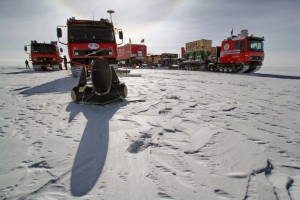Did you know that there are lakes under the ice in Antarctica?In 2007, researchers discovered several lakes under the Recovery ice stream in Dronning Maud Land. Satellite data suggested that the combined area of these lakes was nearly that of the Antarctica’s largest lake, Vostok (which in turn is almost as big as Lake Ladoga in Russia). However, radar measurements made on the ground have now shown that these lakes, buried under 3.5 km of ice, are much smaller than first believed.

The radar measurements were done during the Norwegian-American research traverse (TASTE-IDEA) organized during the International Polar Year 2007-2008, when tracked vehicles traveled from the Norwegian research station Troll in Dronning Maud Land to the South Pole. Glacial radar data from the traverse showed that the water level in at least two of the lakes has previously been much higher, which indicates that there has been outflow of water at some time. The data also indicated that the ice cap over much of this region rests upon soft, wet sediments, rather than lakes. A few other lakes were discovered nearby, in which the water level had decreased quite recently. These research findings reveal that there is a dynamic system of water, rivers, seepage and wet sediment under the ice. We know from earlier research that water and soft sediments under a glacier influence how quickly the ice moves towards the coast, which in turn has impact on how quickly sea level can rise. It turns out that the Recovery area has precisely the characteristics that must be in place to facilitate rapid movement of ice from the central parts of Antarctica out to the ocean. TASTE-IDEA carried out the first ground-based measurements that had been done in this part of East Antarctica since the 1960s. Several experts from the Norwegian Polar Institute participated in thetraverse, which is considered to be the most extensive Norwegian research expedition in modern times. The objective of TASTE-IDEA was to gain better understanding of climate change in East Antarctica. The research also shed light on how the climate in this area has changed in the past, and how Dronning Maud Land might be expected to change in the future. |
South Pole 1911–2011 is an informational outreach project run by the Norwegian Polar Institute
Contact person:


